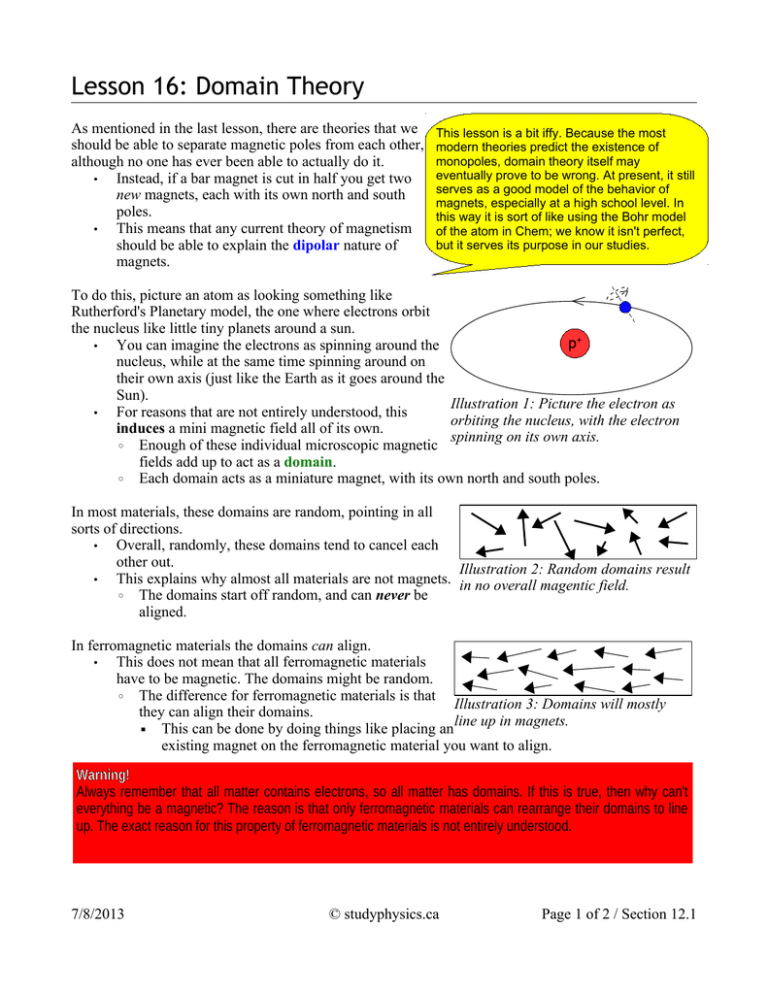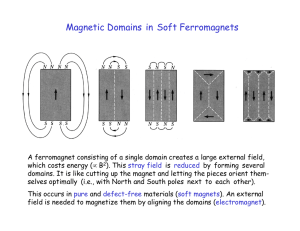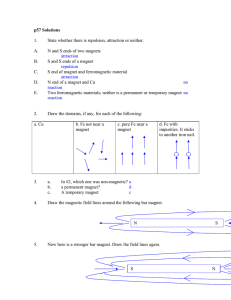Lesson 16: Domain Theory
advertisement

Lesson 16: Domain Theory As mentioned in the last lesson, there are theories that we should be able to separate magnetic poles from each other, although no one has ever been able to actually do it. • Instead, if a bar magnet is cut in half you get two new magnets, each with its own north and south poles. • This means that any current theory of magnetism should be able to explain the dipolar nature of magnets. This lesson is a bit iffy. Because the most modern theories predict the existence of monopoles, domain theory itself may eventually prove to be wrong. At present, it still serves as a good model of the behavior of magnets, especially at a high school level. In this way it is sort of like using the Bohr model of the atom in Chem; we know it isn't perfect, but it serves its purpose in our studies. To do this, picture an atom as looking something like Rutherford's Planetary model, the one where electrons orbit the nucleus like little tiny planets around a sun. p+ • You can imagine the electrons as spinning around the nucleus, while at the same time spinning around on their own axis (just like the Earth as it goes around the Sun). Illustration 1: Picture the electron as • For reasons that are not entirely understood, this orbiting the nucleus, with the electron induces a mini magnetic field all of its own. spinning on its own axis. ◦ Enough of these individual microscopic magnetic fields add up to act as a domain. ◦ Each domain acts as a miniature magnet, with its own north and south poles. In most materials, these domains are random, pointing in all sorts of directions. • Overall, randomly, these domains tend to cancel each other out. Illustration 2: Random domains result • This explains why almost all materials are not magnets. in no overall magentic field. ◦ The domains start off random, and can never be aligned. In ferromagnetic materials the domains can align. • This does not mean that all ferromagnetic materials have to be magnetic. The domains might be random. ◦ The difference for ferromagnetic materials is that Illustration 3: Domains will mostly they can align their domains. line up in magnets. ▪ This can be done by doing things like placing an existing magnet on the ferromagnetic material you want to align. Warning! Always remember that all matter contains electrons, so all matter has domains. If this is true, then why can't everything be a magnetic? The reason is that only ferromagnetic materials can rearrange their domains to line up. The exact reason for this property of ferromagnetic materials is not entirely understood. 7/8/2013 © studyphysics.ca Page 1 of 2 / Section 12.1 The question comes up as to whether or not doing something to a piece of iron will make it a permanent or a temporary magnet. The terms “hard” and • This depends mostly on how the metal is forged. “soft” iron only refer to • If the domains are pretty much locked in place, then a permanent its magnetic properties. magnet will be formed. If this is done with iron, it is called hard iron. Neither of the two irons • If the domains can be moved around easily, then temporary magnets is actually physically harder or softer than will be formed. This would be soft iron. the other. ◦ Soft iron is useful if you want to make something like an electromagnet to pick up cars. It allows the magnetic field to be “switched” off and on. We will look at electromagnets in more detail later. Domain theory also gives us an easy way to look at demagnetizing an existing magnet. • If you drop a magnet on the floor or strike it with a hammer, you are basically adding energy to the atoms of magnet. ◦ Some of this extra energy will cause the atoms (and the electrons) to jiggle around more randomly. ◦ This will screw up the alignment of the domains. • Heating a magnet has pretty much the same effect, since raising the temperature will also increase the random motion of the electrons Remember that “K” stands for “degrees Kelvin.” To and domains. ◦ Above a certain temperature, known as the Curie temperature convert it to degrees Celsius, just subtract about 273O. (1043 K for iron), a magnet cannot be made at all. Homework p592 #11, 12 7/8/2013 © studyphysics.ca Page 2 of 2 / Section 12.1

